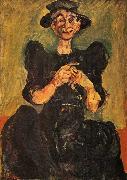Wholesale Oil Painting No Minimum |
|||||||||||
|
|
|||||||||||

|
|||||||||||
|
|
|
||||||||
Chaim SoutineChaim Soutine Art Locations Lithuanian 1893-1943 Soutine was born in Smilavichy near Minsk, Belarus (then part of the Russian Empire). He was the tenth of eleven children. From 1910?C1913 he studied in Vilnius at the Vilna Academy of Fine Arts. In 1913, with his friends Pinchus Kremegne and Michel Kikoine, he emigrated to Paris, where he studied at the Ecole des Beaux-Arts under Fernand Cormon. He soon developed a highly personal vision and painting technique. For a time, he and his friends lived at La Ruche, a residence for struggling artists in Montparnasse, where he became friends with Amedeo Modigliani. Modigliani painted Soutine's portrait several times, most famously in 1917, on a door of an apartment belonging to Leopold Zborowski, who was their art dealer. Zoborowski supported Soutine through the World War I, taking the struggling artist with him to Nice to escape the German bombing of Paris. In 1923, the American collector Albert C. Barnes visited his studio and immediately bought sixty of Soutine's paintings. Soutine once horrified his neighbours by keeping an animal carcass in his studio so that he could paint it (Carcass of Beef). The stench drove them to send for the police, whom Soutine promptly lectured on the relative importance of art over hygiene. In February 2006 this painting sold for £7.8 million to an anonymous buyer in London. Soutine produced the majority of his works from 1920 to 1929. He seldom showed his works, but he did take part in the exhibition of Independent Art held in 1937 in Paris, where he was at last hailed as a great painter. Soon thereafter France was invaded by German troops. As a Jew, Soutine had to escape from the French capital and hide in order to avoid arrest by the Gestapo. He moved from one place to another and was sometimes forced to seek shelter in forests, sleeping outdoors. Suffering from a stomach ulcer and bleeding badly, he left a safe hiding place for Paris in order to undergo emergency surgery, which failed to save his life. On August 9, 1943, Chaim Soutine died of a perforated ulcer. Soutine was interred in Cimeti??re du Montparnasse, Paris. |
||||||||
|
|
||||||||
Woman Knitting
Woman Knitting Painting ID:: 3781 |
1924-25
84 x 61cm
Norton Simon, Los Angeles
1924-25 84 x 61cm Norton Simon, Los Angeles |
|||||||
|
|
||||||||
|
Jean Francois Millet 1814-1875 French Jean Francois Millet Galleries Millet was the first child of Jean-Louis-Nicolas and Aim??e-Henriette-Adelaide Henry Millet, members of the peasant community in the village of Gruchy, in Gr??ville-Hague (Normandy). Under the guidance of two village priests, Millet acquired a knowledge of Latin and modern authors, before being sent to Cherbourg in 1833 to study with a portrait painter named Paul Dumouchel. By 1835 he was studying full-time with Lucien-Th??ophile Langlois, a pupil of Baron Gros, in Cherbourg. A stipend provided by Langlois and others enabled Millet to move to Paris in 1837, where he studied at the Ecole des Beaux-Arts with Paul Delaroche. In 1839 his scholarship was terminated, and his first submission to the Salon was rejected. After his first painting, a portrait, was accepted at the Salon of 1840, Millet returned to Cherbourg to begin a career as a portrait painter. However, the following year he married Pauline-Virginie Ono, and they moved to Paris. After rejections at the Salon of 1843 and Pauline's death by consumption, Millet returned again to Cherbourg. In 1845 Millet moved to Le Havre with Catherine Lemaire, whom he would marry in a civil ceremony in 1853; they would have nine children, and remain together for the rest of Millet's life. In Le Havre he painted portraits and small genre pieces for several months, before moving back to Paris. It was in Paris in the middle 1840s that Millet befriended Constant Troyon, Narcisse Diaz, Charles Jacque, and Theodore Rousseau, artists who, like Millet, would become associated with the Barbizon school; Honor?? Daumier, whose figure draftsmanship would influence Millet's subsequent rendering of peasant subjects; and Alfred Sensier, a government bureaucrat who would become a lifelong supporter and eventually the artist's biographer. In 1847 his first Salon success came with the exhibition of a painting Oedipus Taken down from the Tree, and in 1848 his Winnower was bought by the government. Woman Knitting 1856. 1' 3 1/4" x 11 1/2" ( 39 x 29.5 cm ) Bequest of Alfred Chauchard, 1909. |
||||||||
|
|
||||||||
|
Prev Next
|
||||||||
|
|
||||||||
|
Related Paintings to Jean Francois Millet :. |
||||||||
|
|
||||||||
|
CONTACT US |

